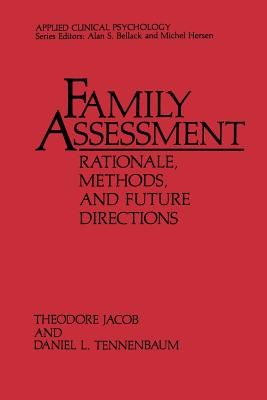
- We will send in 10–14 business days.
- Author: Theodore Jacob
- Publisher: Springer
- ISBN-10: 0306427559
- ISBN-13: 9780306427558
- Format: 15.6 x 23.4 x 1.2 cm, softcover
- Language: English
- SAVE -10% with code: EXTRA
Family Assessment: Rationale, Methods and Future Directions (e-book) (used book) | bookbook.eu
Reviews
Description
The purpose of this book is to review existing and developing family assessment methods relevant to the study of psycho- pathology. It is our intention not only to inform clinical re- searchers of the many valuable family assessment methods that are available, but also to encourage the incorporation of such procedures into future research efforts. In so doing, we believe that our understanding of the etiology, course, treatment, and prevention of adult and childhood disorders will be greatly enriched. The book begins with an overview of the larger social and intellectual forces which have led to the current interest in study- ing family influences on psychopathology in children and adoles- cence. For each stream of influence, we attempt to highlight theoretical and methodological contributions relevant to the fami- ly's role in the etiology, exacerbation, and treatment of childhood disorders. Next, a framework for classifying family measurement procedures is introduced in which three major dimensions are emphasized: unit of analysis, source of data, and construct as- sessed. The third and most important chapter provides detailed reviews of a selected number of methods within each of the major groupings that have been delimited, references and brief descrip- tions of other measures that cannot be reviewed in detail, and a discussion of the promising and developing techniques that are known to the authors.
EXTRA 10 % discount with code: EXTRA
The promotion ends in 10d.23:03:26
The discount code is valid when purchasing from 10 €. Discounts do not stack.
- Author: Theodore Jacob
- Publisher: Springer
- ISBN-10: 0306427559
- ISBN-13: 9780306427558
- Format: 15.6 x 23.4 x 1.2 cm, softcover
- Language: English English
The purpose of this book is to review existing and developing family assessment methods relevant to the study of psycho- pathology. It is our intention not only to inform clinical re- searchers of the many valuable family assessment methods that are available, but also to encourage the incorporation of such procedures into future research efforts. In so doing, we believe that our understanding of the etiology, course, treatment, and prevention of adult and childhood disorders will be greatly enriched. The book begins with an overview of the larger social and intellectual forces which have led to the current interest in study- ing family influences on psychopathology in children and adoles- cence. For each stream of influence, we attempt to highlight theoretical and methodological contributions relevant to the fami- ly's role in the etiology, exacerbation, and treatment of childhood disorders. Next, a framework for classifying family measurement procedures is introduced in which three major dimensions are emphasized: unit of analysis, source of data, and construct as- sessed. The third and most important chapter provides detailed reviews of a selected number of methods within each of the major groupings that have been delimited, references and brief descrip- tions of other measures that cannot be reviewed in detail, and a discussion of the promising and developing techniques that are known to the authors.


Reviews